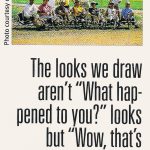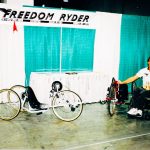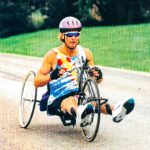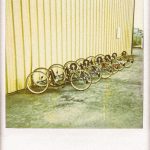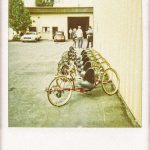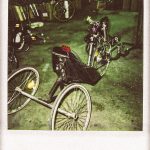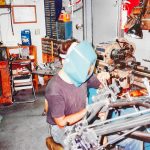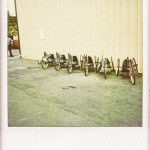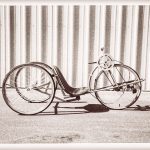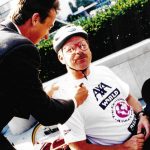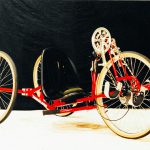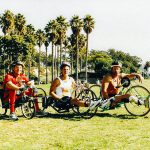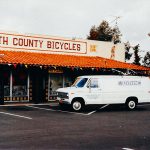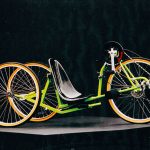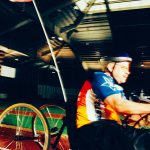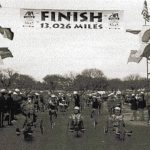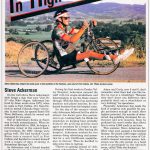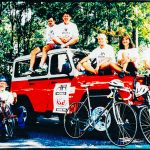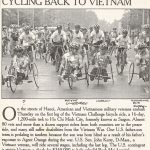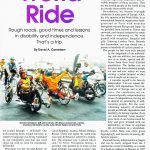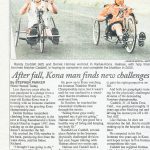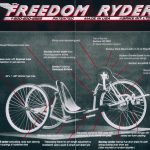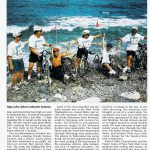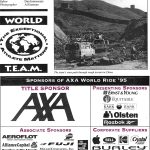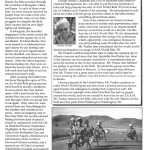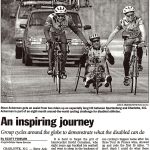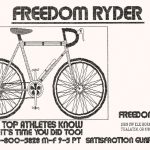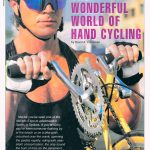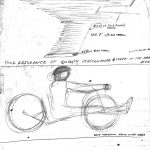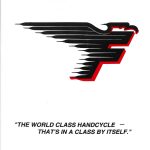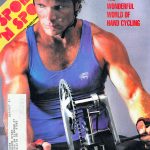It all started in 1984, in Portland, Oregon, when Mike and Brian formed Brike International Ltd. which was building a low-seated, foot-powered three-wheeled design that used a patented “body lean steering”
method. Our design featured a two-piece frame. You sat on the front section, which included the
seat, the front wheel, and the crank assembly. The rear section housed the rear wheels and the
handlebars. The front part of the frame articulated (tilted and turned) on two pivot points
between the two frame pieces. As you leaned your body towards the apex of the corner, the
front wheel, seat, and cranks tilted and turned with you. Two critical aspects of a
high-performance three-wheeled cycle are the ability to lean your body to counteract centrifugal
force during a turn and the ability to pedal throughout the turn.
Over the years, many people with varying types of injuries came to us because they couldn’t ride conventional bicycles. They were overjoyed to discover that our three-wheeled design made it possible for them to rediscover the sport of cycling. Some people came to us with very limited use of their legs, and ultimately, some paraplegics who had no use of their legs at all began to ride. Then, during a demonstration for a partially paralyzed individual who couldn’t ride our foot-powered trike, we realized that our design had inherent features that made it perfectly suited to being powered by hand.
We discovered that by simply moving the foot crank assembly from ahead of the front wheel to above it, the bike could be powered by hand. With this development, the first low-seated, high-performance handcycle was born. We called it the Freedom Ryder. Unlike other designs on the market, which either bolted to a wheelchair or resembled wheelchairs with bicycle-style front forks for steering, our design was entirely different. It offered significantly higher performance and, most importantly, was the most fun handcycle to ride.
The Freedom Ryder featured self-centering steering geometry, which returned the bike upright
and to center after completing a turn. The lean-to-steer design counteracted centrifugal force
like a bicycle, making corners more efficient. It felt like slalom skiing on land or riding a
motorcycle—essentially, like “flying” down the road. This exhilarating and intuitive experience
was unlike anything else available.
As the first high-performance handcycle on the market, word about the Freedom Ryder quickly spread. Handcyclists everywhere began setting distance, speed, and time records on our handcycles. Over time, as the market grew, other companies introduced their own handcycle designs. However, due to our patents, they predominantly used the less efficient bicycle front fork “headset” steering design. This design caused issues such as twisted legs during turns, tire contact with the rider’s legs, and misalignment of the cranks with the body, making pedaling through turns difficult.
Our success and higher performance led other manufacturers to adopt as many design aspects of the Freedom Ryder as they could. Key innovations like the low center of gravity, rider position, cambered rear wheels, side-by-side crank position, and crank assembly adjustments were all pioneered by the Freedom Ryder. However, the “body lean steering design” remained unique to us due to our patents.
As time passed, some potential riders with limited or no trunk control found it challenging to use the “body lean design.” To address this, we developed the “FRH” models, the best fork-steered handcycles available. We resolved issues like leg twisting during turns and loss of front wheel traction—problems still present in competitors’ designs. Our FRH models turn sharper, offer better front-wheel traction for climbing steep hills, and provide unparalleled adjustability.
When you ride an FRH handcycle, you’ll instantly feel the difference. These advancements solidified our reputation for innovation and set new standards for performance. The rest is history!



